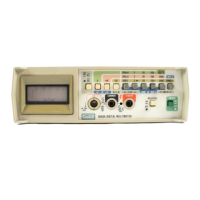MAINTENANCE
LINEAR VOLTAGE TEST
Table
4-7. Resistance
and
Conductance
Tests
DISPLAY
STEP
SELECT
RANGE
INPUT
READING
1
200!1
Short
00.00
to
00.04
2
200!1
100!1
99.88
to
100.14
3
2k!1
1
k!1
.9988
to
1
.0012
4
20
k!1
10
k!1
9.993
to
10.007
5 200
k!1
100
k!1
99.93
to
100.07
6
2000
k!1
1
M!1
997 .2
to
1002.8
7
20M!1
10
M!1
9.972
to
10.028
8 2
mS
1
k!1
.9985
to
1.0015
9 200
nS
10
M!1
99.30
to
100.70
4·42.
CALIBRATION ADJUSTMENTS
4-43.
Under
normal operating conditions the
8050A
requires
calibration
once
every year.
Calibration
adjustments are also required after the instrument has
been repaired or if it fails any of the Performance Tests.
Test equipment required for the adjustments
is
listed in
Table
4-1.
Figure
4-2 shows
the
location
of
all
adjustments
for
the
following
procedures.
For
verification, do the Performance Tests after completing
the
Calibration
Adjustments.
If
portions
of
the
Calibration Adjustments cannot
be
completed, refer to
the Jumper
Selection
procedures given later in this
section.
NOTE
On
the
8050A,
set the
POWER
switch to
ON
and allow the instrument to stabilize
for
approximately
5
minutes.
Perform
the
calibration
adjustments
at an
ambient
temperature
of
23
±5°
C
(79
±9°
F).
WARNING
CALIBRATION
ADJUSTMENTS
ARE
PERFORMED
ON ENERGIZED CIRCUITS.
EXERCISE CAUTION
AT
ALL
TIMES,
AND
USE
A
NON-CONDUCTIVE TOOL
FOR
ALL
ADJUSTMENTS.
4-44. DC
Calibration
4-45.
Use
the following procedure to perform a DC
Calibration:
4-8
l.
Connect the
DMM
Calibrator to the 8050A
as
follows:
HI
to the
V
/k!l/S
input connector and
LO to the
COMMON
input connector.
2.
Select
the DC
V
function on the
8050A.
3.
Turn on the
DMM
Calibrator.
4.
For
each step in Table 4-8, select the range
shown, and adjust the DMM Calibratorforthe
required
8050A
voltage input level, then adjust
the indicated component to the display limits.
5.
This
concludes
the
DC
Calibration
Adjustment. Remove power from the
DMM
Calibrator before dismantling the test setup.
4-46. AC Calibration
4-47. Use the following procedure to perform an AC
Calibration:
I.
Connect the
DMM
Calibrator to the 8050A
as
follows:
HI
to the
V
/k!l/
S
input connector and
LO to the
COMMON
input connector.
2.
Select
the AC
V function.
3.
For
each step in Table 4-9, select the range
shown, and adjust the
DMM
Calibrator to the
required
8050A
voltage
input
level
and
frequency,
then
adjust
the
indicated
component to the display limits.
4.
This completes the AC Calibration procedure.
Remove power from the
DMM
Calibrator
before dismantling the test setup.
4-48. Jumper
Selection
4-49.
If
the calibration adjustments do not bring the
instrument within specifications or if certain critical
components (VRI
or
U32)
have been replaced, complete
one
of
the followingjumper selection procedures. Jumper
locations are shown in Figure
4-2.
4-50.
U5
JUMPER
SELECTION
4-5
l.
The
U5
jumper selection procedure should be
performed if VRI has been replaced
or
if
Rl
I does not
have a sufficient adjustment range. Use
the following
procedure to select the proper resistance for
U5:
l.
Using
the 5-pin
connector
(p/n
537514)
provided with the replacement parts kit, short
MP20
jumper positions A-B-C-D.
2.
On
the
8050A,
set the POWER switch to
ON.
3.
Adjust
Rll
fully counterclockwise.
4.
Select
DC
V function,
2V
range.
5.
Connect the
DMM
Calibrator to the
8050A
as
follows:
HI
to the
V /
kO/ S input connector and
LO to the
COMMON
input connector.
6.
Adjust the
DMM
Calibrator to +I.8888V
de.

